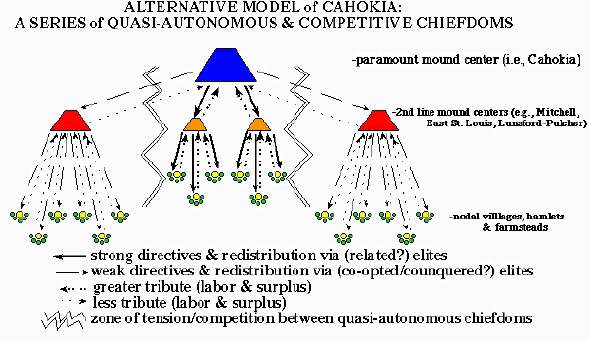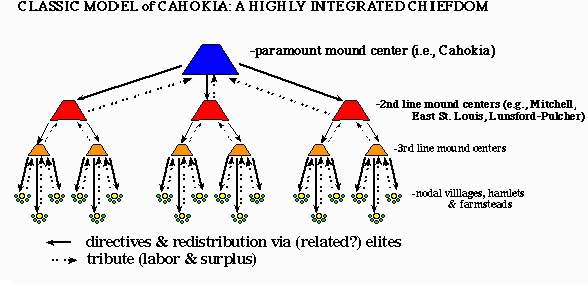|
In this view Cahokia was a stable complex chiefdom that exercised
enormous influence not only over groups in the American
Bottom, but also over peoples throughout eastern North
America. Evidence cited for this interpretation
includes (a) a four-tier or more settlement pattern with
settlements of varying size and internal complexity, (b)
planned mound center layout including open plazas, (c) a
large urban population, (d) extensive trade throughout
eastern North America, and (e) widespread commonality in
religious symbolism in the eastern U.S. (the so-called
Southeastern Ceremonial Complex). Some have even argued on
the basis of these data that Mississippian Cahokia was so
integrated that it attained a quasi-state level of social
organization, much like the pre-Columbian states of the
Aztecs, Toltecs, and Mayans of Mexico and Central
America.

Alternative model of the Cahokia chiefdom.
Recently, however, other scholars have argued that an all powerful Cahokia of
quasi state-like status with far-reaching influence is
questionable because it "stretches" the
available archaeological data. To be sure, this conservative
view agrees that Cahokia was the center of a complex
Mississippian chiefdom, undoubtedly the most densely
populated, politically powerful, and religiously important
in this stretch of the Mississippi River valley. What many
take issue with is the stability of the socio-political
system and the level of control and influence that the
Cahokia elite were able to exercise over people within and
far removed from the American Bottom. In this view, other
towns with mounds and associated smaller communities represent largely self-sufficient
and autonomous chiefdoms that were not immediatly responsive to every whim of the Cahokia elite. Accordingly, the political and
social landscape of the American Bottom is believed to have
been segmented into a series of separate districts, each led by a chief highly. Relations among them were highly competitive and volatile. As the power of quasi-autonomous
chiefs waxed and waned, so too did their threat to, or
support of, the paramount chief at Cahokia. Thus, the stability and cohesion of the Cahokia dominated regional chiefdom varied over time.
Furthermore, according to this interpretation of the
archaeological evidence, while Mississippians of the
American Bottom certainly interacted with various other
cultures throughout eastern North America, their influence
in these distant places was quite limited and often indirect.
|
